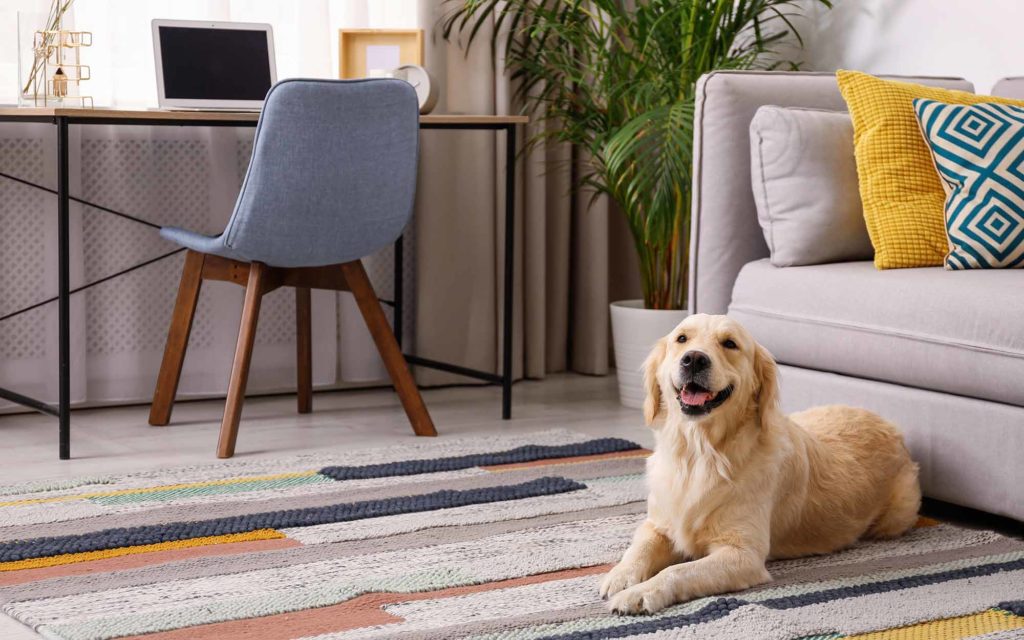Having furry friends in your home can be a delight, but pets bring a variety of smells and messes with them, as many pet owners know. Although your pets may not be able to help you clean up after themselves, their messes can be easily managed with the right tools and practices.
Deep Cleaning Your House With Pets
By performing daily and weekly maintenance, as well as being prepared for pet accidents, you can keep your house clean and prevent pet odors from taking over your home. Over time, you’ll notice the benefits of keeping a consistent cleaning routine.
Basic Tips and Supplies
Here’s a list of supplies that will soon become some of your best and most trusted friends while cleaning up after your pets.
- Vacuum, mop, and microfiber duster – Remove large amounts of hair by using a duster or vacuum with the right attachments, and quickly take care of paw prints and mud with a mop.
- Spray bottles, rubber gloves, cleaning rags – These are your essentials for applying and blotting cleaning solutions to stains and accidents.
- White vinegar, baking soda, bleach, and ammonia – These cleaning agents and the solutions they form can be used to remove stains, reduce odors, and clean many other pet messes.
- Dish soap and dish detergent – Used in combination with the clean agents listed above, these kitchen essentials act as surfactants, letting water into smaller spaces and making it easier to clean messes.
Learn more about The Purple Maids’ residential house cleaning services.

Best Practices for Managing Standard Pet Messes
Once you’ve identified dusty areas in your home, it’s time to develop a plan to clean them. The good new
Sweeping and vacuuming your home with relative frequency can prevent the buildup of dog and cat hair and dander throughout your home. These are the first steps in deep cleaning your pet-filled household, since most of the messes from dogs and cats come from shedding, scattered food, and litter tracked throughout the home. Using a crevice tool is great for removing hair from tight spaces, like behind the couch or under a coffee table. A microfiber duster can be used to tackle most of the hair collected on hardwood floors, too.
A simple 1:1 solution of white vinegar and water is a great, pet-friendly way to clean up paw prints that have been tracked throughout your home. Cats love to climb on windowsills and counters, and their paw pads can deposit dirt on all types of surfaces. Coming in from outside, dogs can track mud and dirt onto your floors as well. In both cases, you can quickly wipe up their prints with this solution and a cleaning rag, keeping the surfaces of your home sparkling.
For lingering odor on your furniture or clothing, use baking soda. Sprinkle some onto furniture, carpets, and upholstery, let it soak for a few minutes, and simply vacuum it up. Adding a dash of baking soda to your next load of laundry can remove pet odors from your clothing and linens too, making your home smell bright and clean.
Cleaning With Dogs in the House
Whether you’re trying to remove dog hair from furniture or keep wood floors clean with dogs, there’s a simple solution: brush your dog on a regular basis. Many dogs love it, and it benefits you both. With regular brushing, less hair will be shed on furniture and floors. However, when you inevitably find hair clinging to your upholstery, try using a rubber glove or damp hand to wipe the furniture. This simple process can actually remove a majority of the hair from the fibers of the furniture. For hardwood floors, use a damp mop or microfiber duster to pick up the hair scattered around the ground. Make sure to get around the baseboards and behind furniture.
If your dog ever has an accident on the carpet, don’t fret. Using a few of the cleaning agents listed above can help you remove stains and odors from your furniture and carpets.
For pee, mix a solution of 1 cup of water and dash of dish soap or detergent, and blot the stain with a cloth. Then, blot again with a similar mixture of ammonia and water to eliminate the odor. Finally, blot the stain with a white vinegar and water solution. When you’re done, dry the spot to prevent the growth of mildew in your carpet.
For poop, first clean up the excess and throw it away. You can then blot the stain with the same ammonia mixture as you would for pee, but this time, let it soak for a few minutes. Repeat this process until the stain is gone. After the stain is removed, rinse the carpet with cool water. To prevent any lingering odors, sprinkle the spot of the accident with baking soda, let it sit for a while, then vacuum it up.
hen dusty areas are in reach, dusting is a straightforward task, but what should you do when you have to dust in high spots or hard to reach areas like light fixtures and the tops of cabinets? If you want to make sure those out-of-reach areas stay dust-free, invest in a duster with an extendable handle. If you have to get around corners or into tight crevices, a bendable duster should do the job.
You may also need a small indoor step ladder when the extendable handle doesn’t reach far enough. Other than that, dusting in high places is not more complicated than your standard dusting regimen.
How To Keep a House Clean With Cats
Our lovely feline friends can also cause a variety of messes in your house. Like with dogs, brushing your cat regularly can help reduce the overall amount of cat hair throughout your home. Unlike dogs, cats have their own indoor bathroom, so you usually won’t need to worry much about them having accidents on your floors or furniture. However, if they poop or pee outside of their litter box, you can use the same steps mentioned above to deal with the accident.
Let’s talk about that litter box, though. Cats are pretty tidy creatures; they clean themselves throughout the day and even have strong preferences about the quality and freshness of their drinking water. If their litter box is too full or not clean enough for their liking, they might choose to do their business elsewhere, like on your carpets or furniture. With this in mind, it’s important to scoop out clumps and solid waste daily to prevent foul odors from taking over your home and to keep your cat happy.
You should also be deep cleaning your cat’s litter box on a weekly basis. To do so, empty all the contents and take them out to the trash. Then, fill the litter box with hot water and bleach, and let it soak for a while. This will help remove lingering odors. After the soak, rinse the litter box thoroughly, dry it, and fill it back up with litter.
If your cat is constantly tracking litter throughout your home, you might also consider putting a liner or flat tray underneath the litter box, or tucking the litter box away in a closet or cabinet. Just make sure your cat has access to it when they need it, or you might have to deal with more accidents.
The Purple Maids Offer Professional House Cleaning After Pets
Contracting a professional home cleaning service can help you keep up with the messes that your pets make. If your dog consistently tracks mud through your kitchen or your cat struggles to keep their litter contained, a professional cleaning company like the Purple Maids can routinely keep those areas of your home clean. The Purple Maids offers a wide variety of services that help keep pet messes and odors from taking over your home, ranging from daily, weekly, or biweekly housekeeping to special request cleaning for those highly specific household needs and pesky stains.
